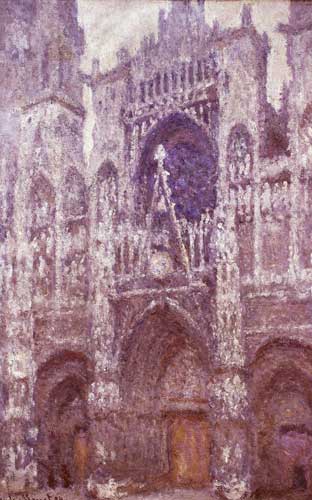Great Works: Rouen Cathedral: The Portal, Grey Weather (1892) by Claude Monet

Fog and art: around 1900, they went hand in hand. Oscar Wilde took fog as proof that art can alter our perceptions. "Where, if not from the Impressionists, do we get those wonderful brown fogs that come creeping down our streets...? There may have been fogs for centuries in London. I daresay there were. But no one saw them, and so we do not know anything about them. They did not exist till Art had invented them."
Going further, the psychologist Edward Bullough saw fog as an object lesson in how art works. When a fog descends, it introduces "psychical distance" between us and the world around us. "Blurring the outline of things and distorting their shapes into weird grotesqueness", fog lets us stand back from our experience. We view things "with the marvelling unconcern of a mere spectator". It makes the world like art.
But behind these fogs hangs the art of Claude Monet. His paintings are filled with river vapour, city smog, morning and evening mist. His series of Rouen Cathedral offers more than 30 views of the façade in different lights and different blurs. Rouen Cathedral: The Portal, Grey Weather is one of the more blurry depictions. What does Monet see in mist?
It transforms, of course: "blurring the outline of things and distorting their shapes into weird grotesqueness" isn't a bad description of what happens to the Gothic sculptings and tracery. Losing definition, dispersing, the architecture becomes more fluid, organic. Rouen Cathedral could be metamorphosing into Gaudi's Sagrada Familia in Barcelona. It's dematerialising, too. The stone front looks like a ghost of a skeleton.
The blurring is assisted by the cropping. Monet frames the building close. He cuts off its edges, hardly showing any profile, except a little at the top. He cuts off the ground. We don't see the cathedral as a distinct object with a shape. It becomes a screen that fills the picture's field. We see it as an optical phenomenon, a looming vision or projection, hovering somewhere or other before our eyes.
Through blur and crop, we lose distance. The cathedral isn't something over there, viewed across an interval of space. It's a sight that comes right up to our eyes. Or rather, the sight is not the cathedral. It's the cathedral-in-mist, and the mist that envelops the building envelops the painter, too. Monet's painting is in the thick of it. The canvas itself seems to have been painted through mist, its pigment obscured and condensing with its vapour. The picture is enfolded and infiltrated by its subject.
Monet goes beyond Wilde or Bullough. This is not fog-appreciation. It's not psychological detachment. He's using painted mist as a medium to dissolve the difference between the perceiving self and the perceived world.
About the artist
Claude Monet (1840-1926) created a name. His 1873 painting, 'Impression: Sunrise', baptised a movement. His art's stress was increasingly on the artist's own sensory equipment. He painted like a man who can hear bats, attuned to remote frequencies of perception. He can see colours and contrasts and radiances that most people can't.
Join our commenting forum
Join thought-provoking conversations, follow other Independent readers and see their replies
Comments
Bookmark popover
Removed from bookmarks